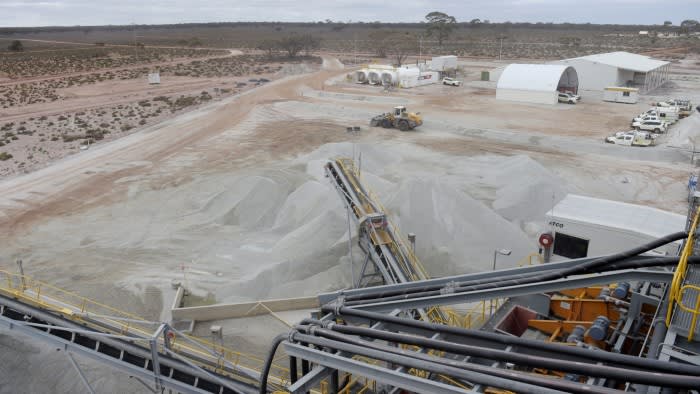
Lithium miners are cutting costs and scaling back plans to expand production after slowing demand in China for electric vehicles crushed the price of the battery metal.
The price of lithium has tumbled more than 80 per cent in the past year to $13,200 per tonne, its lowest level since 2020, after excessive levels of supply hit the market, according to data group Benchmark Mineral Intelligence.
The fallout has pushed miners — mainly in Australia, which produces 40 per cent of the world’s supplies — to constrain production as decelerating demand for electric vehicles leaves stockpiles of half-processed material through the supply chain.
“We’re going through a period where too many new projects came online in too short a space of time,” said William Adams, head of commodity markets research at Fastmarkets, a price reporting agency. “We’ve just started to see the pullback.”
While lithium has not fallen as low as its 2019-2020 slump, when it hit a trough of about $6,000 per tonne, the profitability of many producers is stretched at current levels.
Goldman Sachs estimates a surplus of 200,000 tonnes of lithium carbonate equivalent, or 17 per cent of global demand, this year, which will require “substantial supply cuts” to balance the market.
But politicians and executives in Australia worry that it is miners there which are most exposed to the unexpected speed and depth of lithium’s decline, after their projects were the first to feel the ripple effects.
On Wednesday Pilbara Minerals, a key player in Australia’s lithium industry with a A$10bn market value, warned that it would not pay a first-half dividend after a 46 per cent drop in revenue in the three months to December, due to the volatile price for lithium.
Earlier this week Liontown Resources had an agreed A$760mn loan to bring its maiden Kathleen Valley project into production unexpectedly canned because of the sliding lithium price. The lending package for Kathleen Valley, set to be one of the world’s largest lithium mines, was contingent upon a previous, higher price forecast.
The group, backed by Australia’s richest person Gina Rinehart, is reviewing its mine expansion and scrambling to secure a smaller loan after its share plummeted by a fifth, valuing the company at less than A$2.2bn ($1.45bn).
Albemarle, one of the world’s largest lithium companies, has forecast that capital expenditure this year will drop to $1.6bn from $2.1bn in 2023, to conserve cash. It will also cut jobs and $95mn of annual costs.
Core Lithium, operating out of Australia’s Northern Territory, said this month it had stopped mining and was going to write down the value of its assets, as it shifted its business to merely processing stockpiled ore due to the price collapse.
The rush to halt a potential gush of new supplies on to the market comes with manufacturers already struggling to shift the backlog of lithium in global supply chains. In particular, electric vehicle sales have cooled in China, the world’s largest market, and automakers warn of a “bloodbath” from discount wars on unprofitable electric models.
Fully electric vehicle sales increased 84 per cent to 5.4mn units in 2022 but preliminary data suggests growth last year was only 25 per cent, according to official Chinese data.

Australia’s mining minister Madeleine King met industry heads on January 18 to discuss an “urgent plan” to address the impact on local miners of the price crashes in lithium and also in nickel, which fell 43 per cent last year on oversupply issues.
“Commodities traditionally go through natural and cyclical boom and bust cycles, but the potential prolonged impact this could have on Australia’s energy transition, local workforce and development of Australia’s minerals sector is a matter of great concern,” she said in a statement.
Analysts have forecast that China could use the downturn to expand its share and strategic grip across the global lithium market.
Chinese producer Ganfeng Lithium agreed last week to almost double its purchases of spodumene concentrate — a mineral from which lithium can be extracted — over the next three years from Pilbara.
Some Chinese producers of lepidolite, a low-grade, high-cost source material of lithium, have cut output but not as much as expected, says CRU Group, another commodity data firm. New African operations run by Chinese companies are also unprofitable yet less corrective action is being taken, according to CRU Group and Fastmarkets.
“China will see the pullback in prices as an opportunity to stake more claim in the market,” said Adams. “If you look at the huge price increases in 2021 and 2022 for lithium, China managed to react very quickly.”
Martin Jackson, head of battery raw materials at CRU Group, said it was surprising many big western producers were cutting spending as they run some of the industry’s lowest cost operations.
However, he said some prospective producers had “unrealistic” expectations of future prices from the studies that are crucial to securing financing.
Lake Resources, which is planning to develop the Kachi deposit in Argentina, used a long-term price of $31,000 per tonne, he said.
And while the market grapples with the low prices, analysts point out that lithium remains an immature and nascent market, prone to volatile periods.
“Lithium balances are sensitive to small shifts in demand or supply growth, so the market is susceptible to heightened price volatility,” said analysts at Citi. “A supply reaction to the current lower price environment could prime the market for a rebound in the second half of 2024.”

